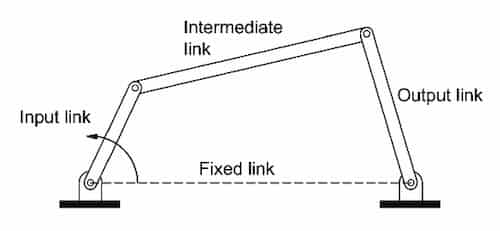Four-bar Linkage
Four bar-shaped members connected to each other in one plane.
Usually:
- 1 fixed link + 3 moving links
- 4 pin joints
- 2 moving pivots + 2 fixed pivots
- 4 turning pairs

- input link - usually denoted in the left.
- output link - usually denoted in the right.
- coupler - intermediate link
- frame - fixed link
Grashof’s law
A four bar mechanism has at least one revolving link if
Here:
Modes of motions
| Mechanism | Shortest link | Criteria |
|---|---|---|
| Crank rocker | Input link | |
| Double crank | Fixed link | |
| Double rocker | Coupler link | |
| Change point | Any | |
| Triple rocker | Any |
crank means a link that makes a full revolution. rocker means a link that doesn’t make a full revolution.
Crank rocker mechanism
Shortest link rotates a full revolution. Output link oscillates.
Double crank mechanism
Shortest link is fixed. Both input and output links rotates a full revolution.
Double rocker mechanism
Shortest link make full resolution. Input and output links makes a full revolution.
Special cases
| Mechanism | Orientation |
|---|---|
| Parallelogram linkage or anti-parallelogram linkage | Equal links are opposite to each other |
| Deltoid linkage | Equal links are adjacent to each other |
Parallelogram linkage
Double crank mechanism. Opposite links are equal and parallel. Angular velocity of input crank & output crank is same. Orientation of the coupler doesn’t change during the motion.
Anti-parallelogram linkage
Double crank mechanism. Angular velocity of input crank is different to output crank.
Deltoid linkage
- Longest link is fixed: crank rocker mechanism
- Shortest link is fixed: double crank mechanism
Non-Grashof’s condition
A four bar mechanism with the property if
Here:
Three links are in oscillation.